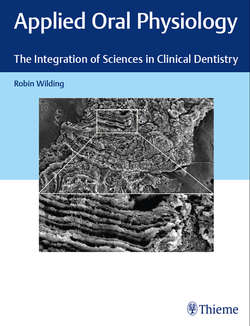Читать книгу Applied Oral Physiology - Robin Wilding - Страница 28
На сайте Литреса книга снята с продажи.
2.3.4 Arrested Caries in Dentin
ОглавлениеArrested caries in dentin is clinically defined by hardness of the dentin surface and a yellow to dark brown color. Arrested carious lesions are found most commonly on lingual and labial aspects of teeth and less commonly in caries which has become arrested, the dentinal tubules in the area between the soft and hard dentin have been shown to be obstructed by large crystals. It has been suggested that this process appears to occur in a number of stages5 (▶ Fig. 2.18).
Fig. 2.18 A diagrammatic representation of the stages in the formation of an arrested lesion in dentin. (a) The dentin tubule contains a high concentration of acid and dissolved mineral salts. (b) If bacterial acid production is reduced, and the pH increases, the salts precipitate into large crystals of tricalcium phosphate which temporally block the tubule. (c) If further bacterial activity is suppressed, the odontoblast process secretes collagen and calcium salts. Crystals of hydroxyapatite (HA) then form and block the tubule more effectively and permanently. (Adapted from Daculsi et al 1987.5)
First stage: The acids produced by advancing bacteria have dissolved the mineral in the surrounding intertubular dentin. The tubular fluid becomes saturated with calcium, magnesium, and phosphate ions. The lesion progresses unless the level of metabolic activity of the bacteria is reduced. If acid production is reduced, then the second stage may occur.
Second stage: When the acid levels drop, the saturated solution precipitates, producing large crystals of tricalcium phosphate. These crystals are comparatively soluble but nevertheless block the tubule.
Third stage: The odontoblast process, protected by the large crystals blocking the tubule, secretes collagen into the dentin tubule. Small plate-like crystals of hydroxyapatite accumulate, which are less soluble than tricalcium phosphate and therefore block the tubule more effectively. At the same time, crystal growth occurs in the intertubular dentin. Zavgorodniy and coworkers conclude that the growth of crystals in arrested caries is both a biomineralization process and a dissolution/precipitation mechanism.6 The dissolution/precipitation mechanism is dependent on the level of acid production by bacteria and the availability of salivary buffers and minerals. These factors determine whether precipitation of minerals or further dissolution will occur. The biomineralization process is dependent on the secretion of collagen by the odontoblastic process, which acts as a scaffold for the precipitation of insoluble apatite crystals.
